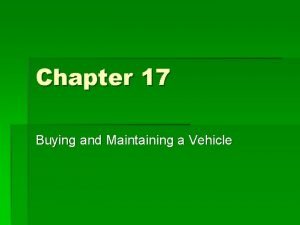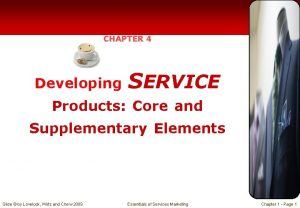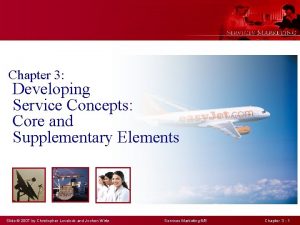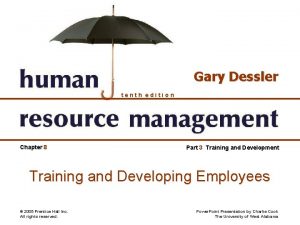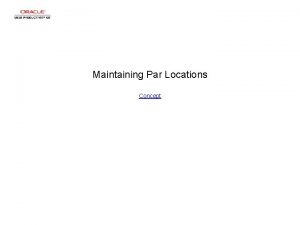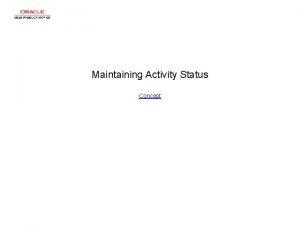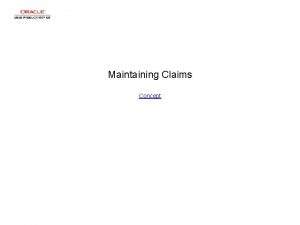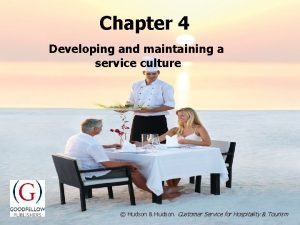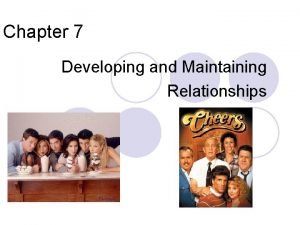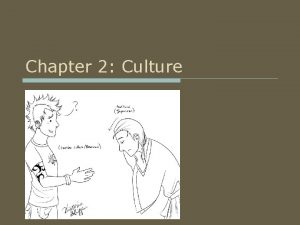Chapter 4 Developing and maintaining a service culture

















- Slides: 17

Chapter 4 Developing and maintaining a service culture © Hudson & Hudson. Customer Service for Hospitality & Tourism

Topics Covered o Internal marketing o Establishment of a service culture o The importance of empowerment o Development of a marketing approach to human resource management o Dissemination of marketing information to employees o Implementation of a reward and recognition system

‘At Your Service’ Spotlight: Four Seasons Hotels and Resorts The Golden Rule Focus on managing mid-sized luxury hotels Service more important than fixtures and fittings • Value-added extras External quality control audits • 300 operating standards Strong internal service culture • Staff recruitment, perks, awards and internal promotion Customer base • Repeat guests, willing to pay, recommend to friends Recognition and Awards • Five Diamond Award, Fortune’s Hall of Fame, Great Place to Work® Award, Robb Report ‘most exclusive brands of all time’

Internal marketing …marketing aimed internally at a company’s own employees o Enables employees to deliver brand promise o Ensure consistently high service o Four-step process: • • Establish a service culture Develop a marketing approach to human resource management Disseminate marketing information Implement reward and recognition system o Too few organizations apply the concept o No unified concept o Corporate distraction (boost revenues, cut costs)

Link Between Internal Marketing and Profits Figure 4. 1

Organizational and marketing cultures o Organizational culture • Formal and informal guidelines, actually activities • Shared values and beliefs, behavioral norms • Individuals understanding of organizational functions o Marketing culture • Unwritten policies and guidelines and behavioral norms • Defines importance of marketing, manner of execution • Internal marketing an extension of a service culture o Service quality a dimension of marketing culture • Delivery and receipt of services

Service culture …. a culture that supports customer service through policies, procedures, reward systems, and actions o Culture must support customer service o Leaders crucial for transmitting, preserving culture o Commitment from management • • positive attitude toward customers and employees time and money transmitting value system properly trained employees respond appropriately empowered to do so by the organization o Establishing a service culture may have regional characteristics

The importance of empowerment …. the act of giving employees the authority to identify and solve guest problems or complaints on the spot, and to make improvements in the work processes when necessary o Impacts customer perceptions of service quality o Essential aspect of internal marketing o Involves decentralized decision-making • Demonstrated trust, respect for employees’ judgment o Gronroos’s interactive marketing concept • Empowered front-line employees • Control over task performance o Contingent on variability of customer needs, task complexity o Not suited to all employees

Empowerment and disempowerment: tourism and hospitality operations Table 4. 1 (Source: based on Lashley, 1995)

Marketing approach to human resource management o Attract and retain good employees • Creative approaches to attracting qualified employees • Understanding the employee market • Building a positive company image o Assist with employee motivation, incentives, training • Changing behaviors difficult, costly post-recruitment • Reduced ambiguity, improved service delivery • Link between training and customer service o Continuous training can improve morale, reduce turnover • Hospitality industry turnover double that of other industries

Developing employee pride o Motivates people to excel • More effective than money or position o Pride builders accomplish this by • Setting aspirations that touch emotions • Pursuing a meaningful purpose • Cultivating personal relationships of respect • Demonstrating high character • Injecting humor

Snapshot: Igniting the Spirit to Serve in Hong Kong Passionately exceeding expectations. o Live Renaissance Values: Intriguing, Indigenous and Independent. o Training and recognition of ‘high guest contact personnel’ • Advance planning and anticipating needs • Clues from guests ‘watch, listen and ACT’ • Flexibility to react spontaneously, counteract problems o Guests made to feel special • Wow factors • Repeat customers pampered o Continuous Improvement • Inspiration from competitors • Newsletters e. g. ehotelier. com • Social Media monitoring • Mystery Shopping

Dissemination of marketing information to employees o Role and importance of employees • Implementation of strategies • Achievement of objectives o Frequency, quality, accuracy of communication • Moderates ambiguity • Increases job satisfaction o Communication mechanisms • • • One-to-one Company meetings Training sessions Newsletters, emails, reports, videotapes Blogs

Southwest’s blog for customers and employees Figure 4. 2

Employee exclusion from the communication cycle o Manager, supervisor failure to convey information o Frontline employees should be informed of • Promotions and new products • Changes in the service delivery processes • Action steps in marketing plan o Poor internal communication a service quality risk • Customer-contact employees not able to deliver advertising promises

Implementation of reward and recognition systems o Employees should be made to feel happy and proud of their jobs • Canadian survey - being made to feel valued important motivator o Organizations should • Communicate performance objectives • Provide relevant training • Provide feedback • Provide recognition (non-cash rewards) • Tailor rewards to the interests of the employees o Employee dissatisfaction may lead to bad publicity

Case Study: West. Jet Airlines: Fostering a caring culture Canada’s Most Admired Corporate Culture o Pride in product intrinsic to West. Jet’s success o Internal service as important as external service • Employee empowerment, spontaneity • 4 Kudos program • CARE department –Create A Remarkable Experience • Sense of ownership, profit sharing
 Chapter 17 drivers ed
Chapter 17 drivers ed Flower of service
Flower of service Facilitating elements of service flower
Facilitating elements of service flower Flower of service model
Flower of service model Chapter 15:5 sterilizing with an autoclave
Chapter 15:5 sterilizing with an autoclave Chapter 11 lesson 1 maintaining a healthy weight
Chapter 11 lesson 1 maintaining a healthy weight Example of pop culture
Example of pop culture Continuous culture and batch culture
Continuous culture and batch culture American culture vs indian culture
American culture vs indian culture Stab and stroke culture
Stab and stroke culture Folk culture and popular culture venn diagram
Folk culture and popular culture venn diagram Popular culture examples
Popular culture examples Site:slidetodoc.com
Site:slidetodoc.com Folk culture and popular culture venn diagram
Folk culture and popular culture venn diagram Carpet culture method
Carpet culture method Carpet culture microbiology
Carpet culture microbiology Surface culture deep culture and esol
Surface culture deep culture and esol Chapter 8 training and developing employees
Chapter 8 training and developing employees
